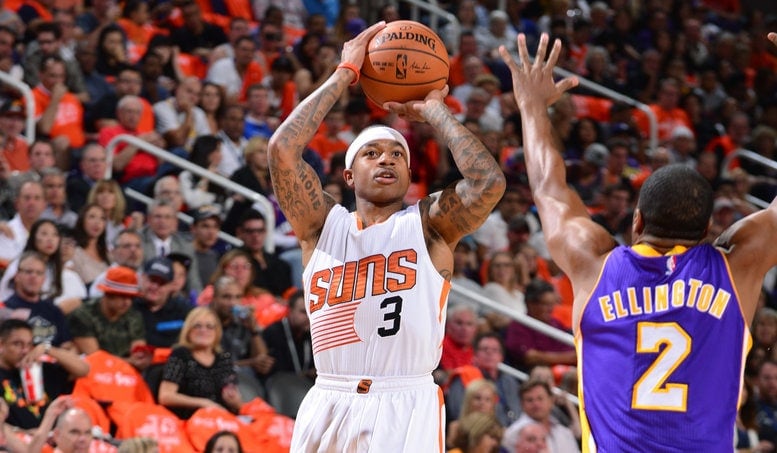After a second consecutive double-digit loss to start the 2014-15 campaign, Lakers head coach Byron Scott was asked to identify the team's biggest problem.
“We’ve got to do a better job of guarding 3’s,” he offered outside the locker room in Phoenix after a 119-99 defeat on Wednesday night. "That’s the thing that in our first two games that has really, really hurt us."
On Tuesday, Houston dropped 12 of their 29 long balls (41.4 percent), followed up by an even better performance from the Suns, who hit an impressive 16 of 32 (50 percent) from 3-point range on the tail end of the season-opening back-to-back.
Isaiah Thomas and Marcus Morris hit five triples apiece for the Suns, while Trevor Ariza dropped five of his own in the season opener for the Rockets.
“Our lack of communication … we’re a step slow, it seems like, on everything," Scott continued. "We’re just not being aggressive enough for longer periods of time. We’re doing it in spurts and then we get right back being lackadaisical going on our heels instead of being the aggressor, and we’ve got to find a way to be aggressive on the defensive end for 48 minutes."
Scott isn't a coach that likes to make many excuses for his team or his players individually, but the plethora of injuries suffered in the preseason (Steve Nash, Nick Young, Xavier Henry, Ryan Kelly, Wayne Ellington) and on opening night (Julius Randle) certainly haven't helped L.A.'s defensive cohesion. So much of defense is playing on a string together with your teammates, and the Lakers have rarely had the same guys on the court next to one another for more than a game or two.
It also doesn't help that Houston attempted the most, and Phoenix the sixth-most, 3-pointers last season. Those are the shots they’re trying to take in excess.
“We gave up a lot of uncontested 3’s and open 3’s two nights in a row with probably two of the best 3-point shooting teams in the league," said Ed Davis, one of the team's bright spots with 25 points, 15 boards, four blocks, three steals and three assists thus far. "We can’t do that."
Meanwhile, the Lakers have hit only 7 of 23 3-pointers as a team … but that shouldn't be too much of a surprise.
“We don’t have (many) 3-point shooters right now," said Scott, citing Wayne Ellington and, to an extent, Jeremy Lin as exceptions. “You can’t play tit for tat.”
It’s really not that Scott doesn’t understand the benefit of shooting 3-pointers. It’s that L.A.’s offense is tailored around its best offensive option, Kobe Bryant, who’s often on the block or the elbow, or Jeremy Lin, whose strength is penetrating on screen/rolls.
And with Bryant playing the shooting guard spot often from the block or the elbow, L.A.’s spacing simply isn’t going to be the same as it was last year with Jodie Meeks out at the 3-point line. Neither Carlos Boozer nor Jordan Hill has 3-point range, and Wesley Johnson isn’t a prolific shooter from behind the arc at 34.6 percent for his career.
Scott will get two shooters back soon enough, however: Nick Young can shoot the triple, hitting 135 last year on 38.6 percent, though he’s out until early December; Ryan Kelly can get them up from distance as well, as the team’s only stretch four, but he’s yet to play and likely won’t return until next week at the earliest from a hamstring injury.
Kobe can certainly drain 3’s, having hit 1,642 of them in his regular season career, but he tends to get them in his own rhythm, often outside of the offense.
Regardless of how many 3’s the Lakers take and make, they absolutely can’t allow the prolific number of makes from their opponents. And if that’s problem No. 1, Scott’s trying to keep things together in a general sense.
“I told them we’ve got to hang in there, we’ve got to stay together, it’s only two games,” he offered. “There are a lot of things we’ve got to continue to work on to get better as a basketball team.”
